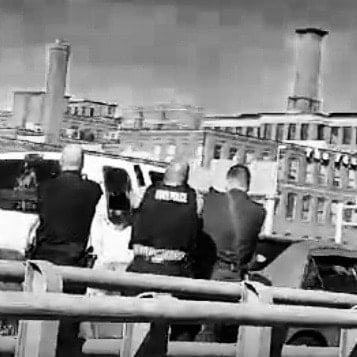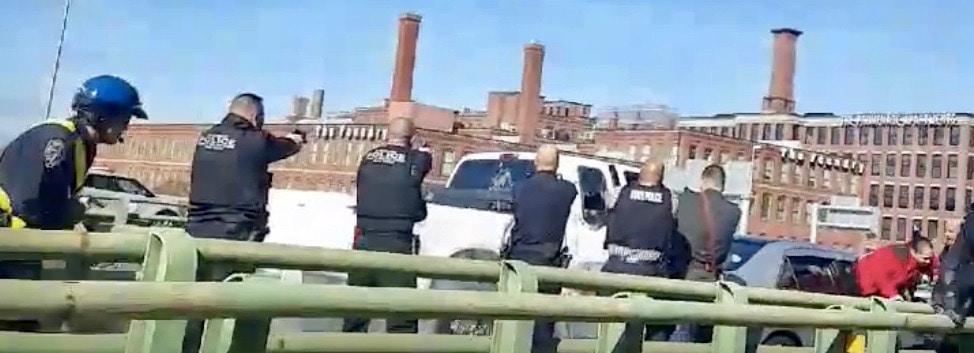A Murder by Police in Rhode Island
[Note: This OpEd was first published on End Police Brutality PVD here.] The person shot earlier today by Rhode Island State Police on I-95 was killed NOT because he caused any harm to civilians but because he was believed to be a person that the police designated as a suspect. The person who they were actually looking for was a
November 9, 2017, 7:30 pm
By End Police Brutality PVD
The person shot earlier today by Rhode Island State Police on I-95 was killed NOT because he caused any harm to civilians but because he was believed to be a person that the police designated as a suspect. The person who they were actually looking for was a person who tried to escape custody earlier in the day and stole their cruiser while he was being transported to the court house. His initial charges before taking the cruiser were obstruction and possession of a stolen vehicle. The person was wanted not necessarily because of his previous charges, but primarily because he disobeyed police commands and tried to escape their custody – actions which are considered to be an affront to their power. Similarly, the narrative circulating about the person who was killed by police is that they refused to yield to police and gave way to a chase – in other words disobeying police commands, thus triggering pursuit rage among the police officers. Even if we were to entertain the idea that the person who was killed did in fact put people in danger because he led police on a chase, it should be noted that high-speed police chases have killed thousands of innocent bystanders, suggesting that disproportionate police response (rather than disobedience to police commands) is what escalates pursuit situations and heightens the chance of injury.
In the midst of their pursuit rage, the police then claimed that the suspect was armed in order to justify their execution of the suspected fugitive, even though media outlets reported that none of the guns in the police cruiser were taken. This narrative of a potentially armed suspect also works to elicit sympathy from the public for having eliminated a supposed threat. It also demands their participation by encouraging people to inform the police about any suspicious activity they feel may be connected to the case.
At this moment, police are not confirming the reason why they even began chasing the person who was eventually shot and killed on I-95. In addition to the person who was killed, there was a woman who injured by police gunfire. You can see them shooting into the car in firing squad formation in the video linked below. Providence Police Commissioner Steven Paré refused to provide information about the victims and went so far as to say that the woman and her behavior are currently under criminal investigation. They have also stated that there were no guns found in the victim’s car.
This is the way that a murder by police occurs in Rhode Island. The police claim that there is a public threat which is also supposedly a danger to their lives; this then gives them license to suspend legal protocols like due process and use deadly force against any person designated as a suspect or threat. This is known as creating a state of exception – areas in time and space were the law is temporarily suspended to exert raw violence beyond legal protocols by state officials. The boundaries of this state of exception are subject to indefinite expansion according to the arbitrary will of the police. There are entire neighborhoods and populations which live under a constant state of exception – the neighborhoods in which Black, Brown, indigenous, and immigrant working-class populations reside.
Police then pass their narrative along to local media outlets, who work to drum up fear among local populations while also garnering support for police, especially from white citizens. Part of this is preemptively vilifying the suspect for disobeying police while normalizing the narrative of ‘officer safety’ and ‘police self-defense.’ When everything is said and done, politicians come out afterward to corroborate the law enforcement narrative, thereby sanctioning the violence used by their officers. When there are holes in their story, as is evidenced in this situation, they appeal to the possibility that the suspect disobeyed police authority and/or posed a deadly threat.
Following the murder, we can expect a doubling down on public relations campaigns by the police in order to rebuild trust and smooth over any sour sentiments among the population. This is the reason why local police departments have adopted a ‘community policing’ strategy, which includes an ongoing campaign to build ‘friendly’ connections with select entities in different populations so as to make it seem like people in a given city or neighborhood are in support of their presence. All of these mechanisms are oriented toward maintaining police legitimacy among the population and also preemptively dissipating the possibility for dissent. In the case that dissent DOES occur, there are sophisticated political, social, cultural, and economic mechanisms in place to channel popular momentum into outlets which barely challenge the foundations of police power and instead re-inscribe their legitimacy. These mechanisms of popular misdirection also function to undermine the capacity of poor and working-class people to self-organize and mount a genuine opposition to police power. They hold ‘community conversations/forums’ in impoverished neighborhoods where they pull out their token Black, Latino, and Asian officers who attend these ‘conversations’ and make it seem like the police force is an institution that can be reformed. Taken together, these strategies are known as counter-insurgency.
Although it may not occur verbatim as described above, keep an eye out for each of these aspects as the situation unfolds.
Sources:
- Man killed by police in Providence did not steal state police cruiser
- 1 dead in officer-involved shooting; cruiser theft suspect still at large
- Police Shooting in Providence Caught on Camera [content warning: gun shots and sirens]
- If You Run, You’re Done: Why Cops Go Berserk When People Run From Them
- ‘Red Mist Of Rage’ Overcomes Many Police In Hot Pursuit
- High-speed police chases have killed thousands of innocent bystanders
- Police pursuits cause unnecessary deaths and injuries, L.A. County grand jury says
- The “Fundamentalism” in Police Operations
- The other side of the COIN: counterinsurgency and community policing







